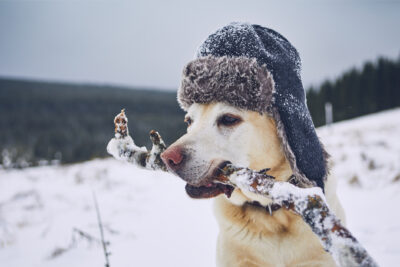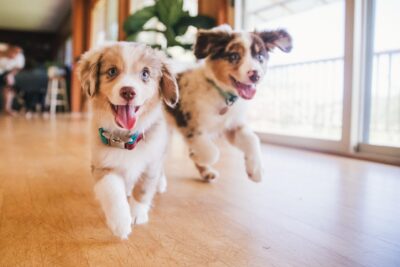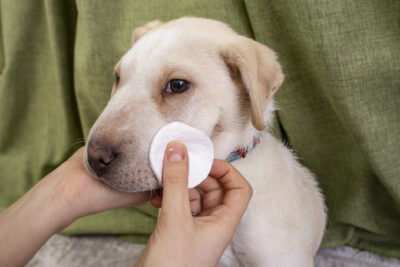Knuckling in Dogs

Overview
Have you ever noticed your dog walking on the tops of their paws, instead of walking with their paw pads on the ground?
If so, your dog may be knuckling. This condition can have a wide variety of potential causes, each of which requires different diagnostic tests and treatments.
Read on to learn more about knuckling in dogs.
What Is Knuckling in Dogs?
Knuckling describes a dog that is walking or standing with its paw folded abnormally. Knuckling dogs are said to be “knuckled over” – they are walking on the tops of their paws, instead of placing weight normally on their paw pads.
Knuckling over in dogs leads to the appearance that a dog is standing with their paws flipped upside-down. They also tend to be awkward and clumsy on the affected paw(s), not placing it on the ground normally when walking or running.
Knuckling has a number of potential causes, varying from mild to severe. Knuckling may affect one paw, two paws, three paws, or all four paws.
Causes of Knuckling in Dogs

Knuckling is often caused by a neurologic condition. Any disease affecting the spinal cord and/or the nerves traveling from a dog’s brain to its limbs can impact a dog’s ability to sense the location of their paws and position them appropriately.
The most common cause of knuckling in dogs is intervertebral disk disease (IVDD). In a dog with IVDD, the rupture or herniation of an intervertebral disk puts pressure on the spinal cord. This compression interferes with the transmission of signals between a dog’s brain and the paws, causing knuckling and other neurologic effects. Breeds at high risk of IVDD include the Dachshund, Beagle, Shih Tzu, Lhasa Apso, Pekingese, Corgi, Cocker Spaniel, and Poodle.
Other neurologic conditions that may cause knuckling include fibrocartilaginous embolism (also known as a spinal stroke), degenerative myelopathy in dogs, cerebellar abiotrophy, brachial plexus injury or other nerve injuries, and tumors affecting the spinal cord.
Less commonly, non-neurologic conditions may cause knuckling. Knuckling in puppies can be associated with carpal flexural deformity or other developmental abnormalities. In older dogs, arthritis pain can lead to knuckling or dragging the paws. Injuries affecting the tendons or ligaments of the limbs can also cause knuckling, due to decreased stability of the joints.
Conditions that cause knuckling may be degenerative (occurring in older dogs), developmental (occurring in young puppies), or related to trauma or injury.
Symptoms of Knuckling in Dogs
The primary symptom of knuckling in a dog is standing or walking on the tops of their paws. You may notice that your dog appears to be walking “funny,” with an abnormal gait. They may be lifting or placing their paws abnormally, as if they are drunk or not quite aware of where their paws are in space.
If your dog is calm and has a good temperament, you can actively look for knuckling. With your dog standing normally on all four paws, gently lift one paw and fold the wrist or ankle before lowering it to the ground with the top of the paw touching the floor. A normal dog should quickly correct this, by flipping the paw over and placing it back on the ground normally. If your dog’s paw remains upside-down, even after you let go of it, your dog is knuckling. See this video for how to test your dog.
Depending on the condition that is causing your dog’s knuckling, you may see other signs of neurologic dysfunction or pain. Your dog may be weak in the limbs, crying out in pain, or reluctant to move. In some cases, however, knuckling is the only sign of a problem.
Diagnosing Dog Knuckling

Your veterinarian will begin by performing a comprehensive physical exam. A neurologic exam will allow your veterinarian to assess your dog’s conscious proprioception (sensation and movement of the limbs) and other aspects of neurologic function. Your veterinarian will also look for signs of other illnesses or injuries that may impact your dog’s limb function.
Next, your veterinarian may recommend baseline laboratory tests. A complete blood cell count, serum biochemistry profile, and urinalysis can be beneficial in uncovering the underlying cause of your dog’s illness. Laboratory tests will help your veterinarian create a treatment plan for your dog, because underlying conditions may influence the best treatment approach for your dog.
Depending on the results of your dog’s physical exam and laboratory tests, additional testing may be recommended. Your veterinarian will likely begin with radiographs (X-rays) of the spine. Advanced diagnostic testing, such as computed tomography (CT) or magnetic resonance imaging (MRI), may also be recommended. Based on the results of diagnostic tests, your veterinarian will be able to diagnose the cause of your dog’s knuckling and recommend an appropriate treatment plan.
Knuckling Treatment for Dogs
Treatment depends on the underlying cause of a dog’s knuckling.
The most common cause of knuckling in dogs is IVDD. Some cases of IVDD respond well to conservative treatments, such as anti-inflammatory medication and cage rest. In more severe cases, surgery may be required to alleviate pressure on the spinal cord and allow a return of normal neurologic function.
When knuckling is caused by a condition other than IVDD, treatment options may vary considerably. Your veterinarian will determine how to treat your dog’s knuckling based on exam findings and the results of diagnostic testing.
Cost to Treat Knuckling in Dogs
The cost to treat knuckling can vary considerably, depending on the underlying cause of your dog’s condition. Conservative treatment, such as rest and anti-inflammatory medication, may cost less than $100. Surgery is considerably more expensive, however, and may cost several thousand dollars.
How to Prevent Knuckling in Dogs

There is no single way to prevent knuckling in dogs, because this condition can have a wide variety of causes.
The most common cause of knuckling is IVDD. While IVDD is not entirely preventable, there are measures that you can take to reduce the risk in high-risk breeds. If your dog is at a high risk of IVDD, limit your dog’s jumping and rough play. Maintain your dog at a healthy weight and work to prevent obesity, which can predispose a dog to IVDD. Finally, talk to your veterinarian if you are concerned about your dog’s IVDD risk.
Developmental causes of knuckling in puppies can sometimes be prevented through the use of an appropriate diet and a good environment. Talk to your veterinarian about the best diet for your puppy, keeping in mind that the best diet for a given dog will depend on size, breed, and other factors.
Also, ensure that your puppy has regular access to secure footing. Spending large amounts of time on slippery surfaces may predispose a puppy to knuckling and other joint conditions.
If you have specific questions about preventing knuckling, talk to your veterinarian for guidance tailored to your dog.









